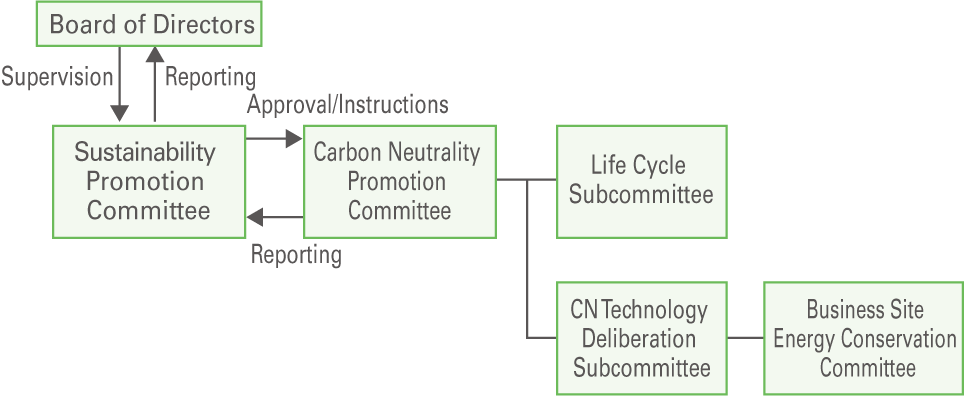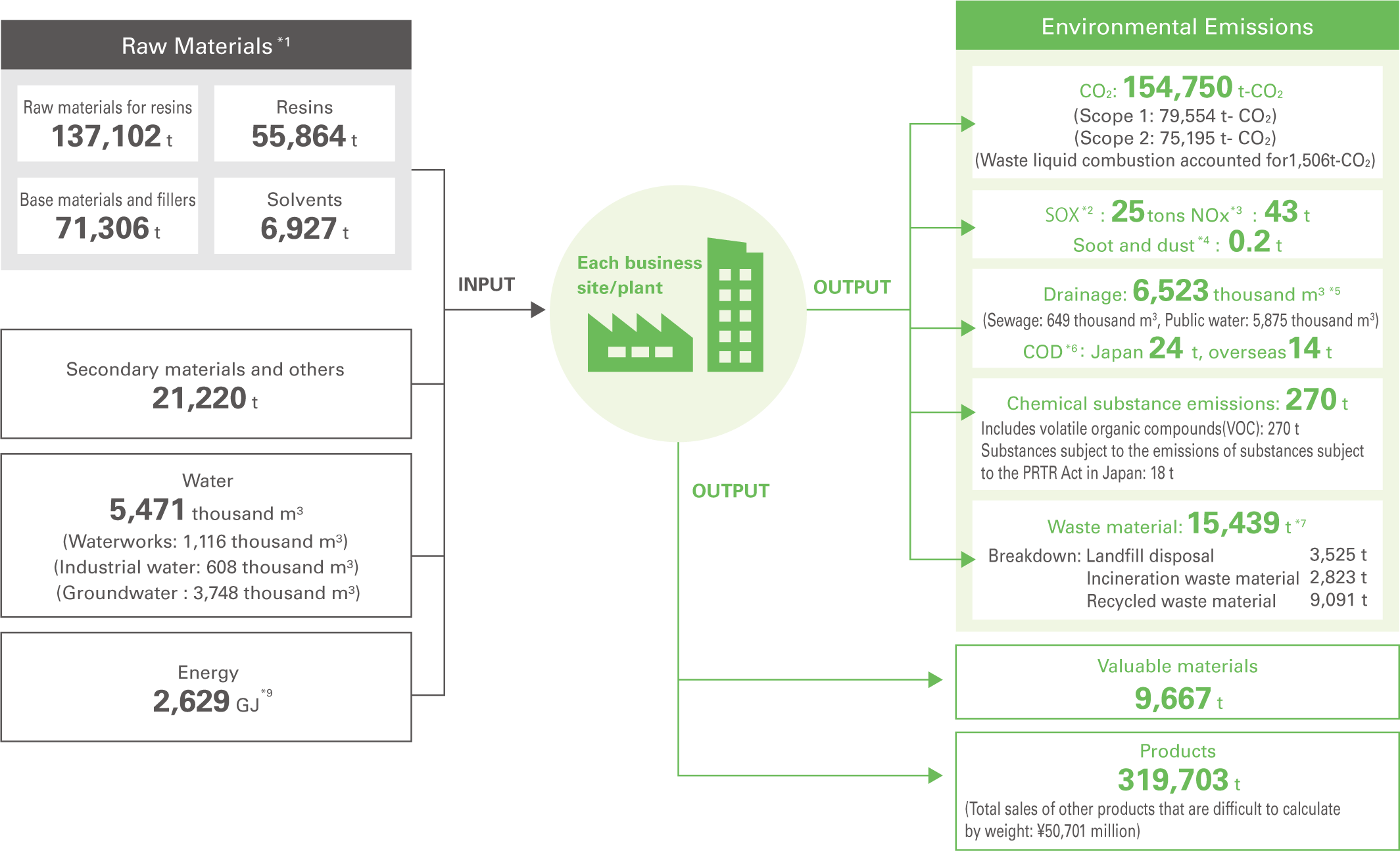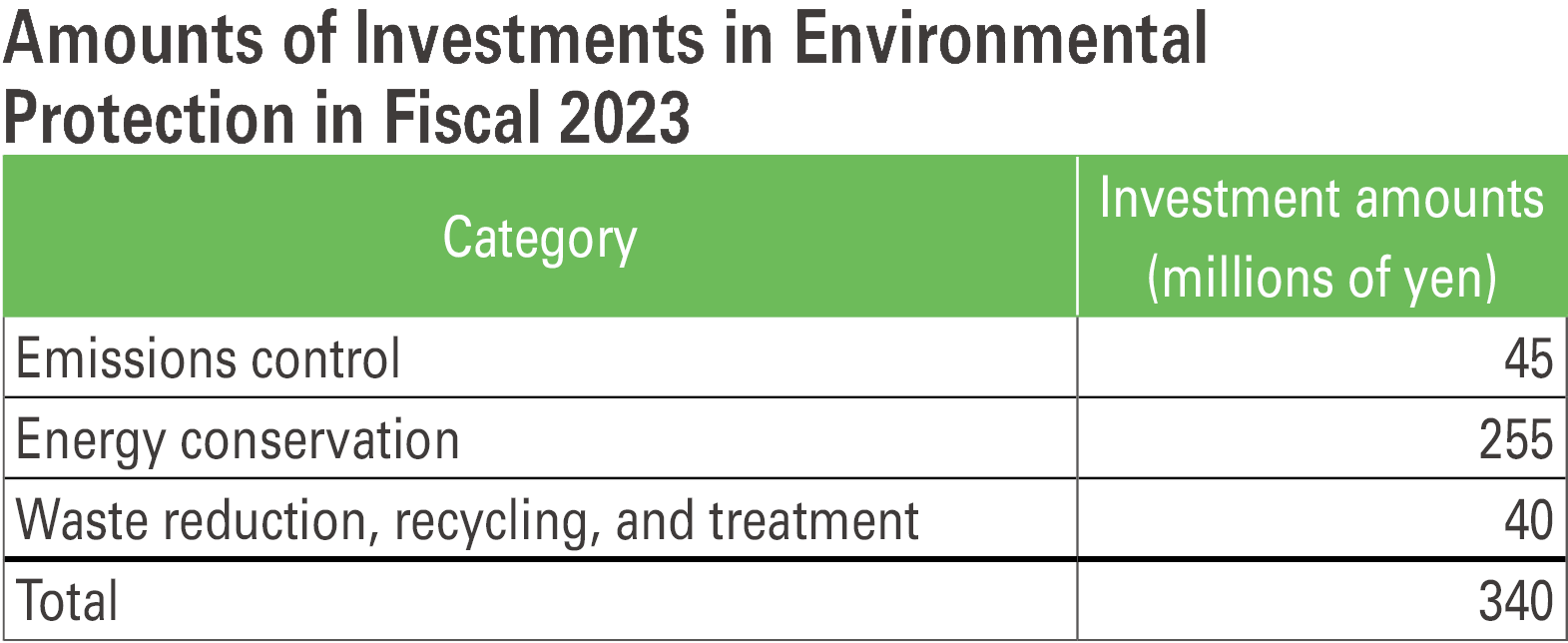Policy and Basic Approach
Environmental Policy (Revised on April 1, 2025)
Basic Policy Statement
We are committed to contributing to a society that strives for the Sustainable Development Goals
(SDGs)
by actively engaging in Responsible Care that prioritize environmental protection, health, and
safety.
Through continuous improvement and evolution of our initiatives, we aim to enhance both social and
corporate value.
- 1) We are committed to building a sustainable society by adapting to and mitigating the impacts of climate change. We strive to reduce greenhouse gas emissions, promote energy saving, and utilize renewable energy, all in line with Science Based Targets (SBT).
- 2) Recognizing the importance of our limited and precious water resources, we are committed to reducing water consumption and promoting reuse. By preventing water pollution and rigorously managing wastewater, we aim to mitigate water risks, contributing to the conservation and sustainable use of regional water environments.
- 3) We are committed to building a circular economy by striving to circulate plastic resources, solve waste problems, and reduce waste through minimizing and optimizing resource usage. We also proactively pursue new initiatives based on 3R (Reduce, Reuse, Recycle) and sustainable resources (Renewable) to build a more environmentally friendly society.
- 4) We strive to reduce environmental impact and properly manage chemicals associated with our business activities to prevent air, water, and soil pollution, as well as noise and vibration. We also address emerging environmental challenges with sincerity, such as the micro- and nanoplastic problem, and continuously improve our efforts.
- 5) We consider biodiversity conservation a key issue and promote initiatives centered on local biotope activities. To broadly disseminate the importance of biodiversity conservation, we continuously engage in outreach programs and dialogue with local communities utilizing biotopes.
- 6) We comply with national regulations through a real-time chemical management system that reflects chemical regulations. We also continuously strive to reduce and eliminate hazardous substances and substances of concern by reviewing the adoption of new raw materials.
- 7) We comply with environmental laws, regulations, and other applicable regulations, and each employee is committed to a high level of compliance awareness.
Scope of Application: This policy is applied to the Group of Sumitomo Bakelite Co., Ltd., including all business sites as well as subsidiaries and affiliates both in Japan and overseas.
Structure (Governance)
We solve social issues and aim to achieve sustainable growth and value creation under a structure comprising our Sustainability Promotion Committee (which is chaired by the President) and its subcommittees based on our Business Philosophy, which upholds the Sumitomo Business Philosophy (Basic policy) and sets forth our management principles.
Environmental management involves running responsible care activities for voluntarily implementing and improving environmental and safety measures, in line with our Group’s Policy on Responsible Care Activities.
Ensuring that measures are in place toward achieving carbon neutrality is deemed essential these days. To this end, the Carbon Neutrality (CN) Promotion Committee, which also encompasses the “Life Cycle Subcommittee” and the “CN Technology Deliberation Subcommittee,” was established to strengthen and promote CN initiatives in the relevant sectors throughout the Group of Sumitomo Bakelite Co., Ltd.

- * The above system diagram is only an excerpt of our committees related to environmental management. See for details. Sustainability Promotion System
Risk Management
The identification, assessment, and management of risks and opportunities related to environmental issues pertaining to our Group (greenhouse gas (GHG) emissions, resource circulation, waste reduction, pollution prevention, water resources conservation, biodiversity conservation, chemical substance management, etc.) are carried out in accordance with the risk management system and risk management process described on the following page.
Metrics and Targets
The metrics and targets for environmental issues pertaining to our Group (greenhouse gas (GHG) reduction, resource circulation, waste reduction, pollution prevention, water resources conservation, and chemical substance management) are listed on the following pages.
Main Initiatives
Obtaining Environmental Management System Certification
Our Group has established environmental management system (EMS) based on ISO 14001 and continues to obtain certifications (27 locations in total as of March 31, 2024).
Material Flows
The figure below shows inputs, including raw materials and energy, and outputs that are products and emissions released into the environment.
The Group is working to minimize its impact on the environment by reducing waste disposed to the environment and reducing the use of raw materials, energy, and water from the perspective of resource-saving. We are also promoting CO2 emissions reduction to achieve carbon neutrality.
Through our ongoing activities, we will contribute to measures against global warming and other climate changes by implementing initiatives that reduce outputs that affect the environment, with respect to increases in input.

- *1: The ratio of renewable raw materials to total raw materials used is about 2.7% at the current point in time, but we will make efforts from the development stage onward in order to increase the ratio of renewable raw materials use.
- *2, 3, 4, and 6: See the Glossary. SOx, NOx, and soot and dust are calculated using the company's own formula based on exhaust gas readings and fuel usage amount, among other variables. Since methods of calculating emissions of soot and dust differ among countries, this figure is compiled solely for business sites in Japan at present. COD is calculated based on the measured concentration and drainage volume. Data on overseas COD covers sites that measure COD within drainage. Data for overseas sites are stated separately because the types of oxidant (potassium dichromate is mainly used overseas) used for measurement differ from those used in Japan.
- *5: Drainage volume is determined by calculating drainage into sewages based on the breakdown of total usage. Drainage into public water areas is calculated using readings from flow meters installed at business sites; while water usage volume is used for business sites without flow meters.
- *7: The volume of hazardous waste found in our waste came to 5,972 t and non-hazardous waste was 9,467 t. Hazardous waste is based on the categorization of each country and is not subject to assurance.
- *8: VOC (Volatile Organic Compounds)
- *9: Energy consumption has been calculated and disclosed based on the Act on the Rational Use of Energy, but has been changed from the conventional crude oil equivalent (kL) to thermal unit (GJ) from the current period. In addition, thermal conversion coefficient of electric consumption has been revised to 3.6GJ/thousand kWh.
- * The volume of products shipped and value of products sold are not subject to assurance.
Investments in Environmental Protection
Our Group has compiled data annually on the amounts of investments in environmental protection of all Group companies in Japan since fiscal 2000.
Since fiscal 2020, we have been engaged in a full-fledged effort to adopt solar power generation based on our commitment to carbon neutrality, and we continued to phase it in at each of our business sites in fiscal 2023. Further introduction is planned for fiscal 2024.
We will continue to promote proactive investments in the reduction of CO2 emissions moving forward.


Topics More
- 2025/11/28 Sustainability Integrated Report 2025 of Sumitomo Bakelite Co., Ltd. has been issued.
- 2025/05/09 Sustainability SBT Certification granted by the SBTi (Science Based Targets initiative)
- 2025/04/14 Sustainability Launch of “Project Team to Prepare for Mass Production of Functional Membranes for Hydrogen Production”
- 2025/02/25 Sustainability Sumitomo Bakelite Co., Ltd. Receives Gold Medal in EcoVadis Sustainability Assessment
- 2024/12/06 Sustainability Integrated Report 2024 of Sumitomo Bakelite Co., Ltd. has been issued.
Email us about Sustainability
Inquiry
